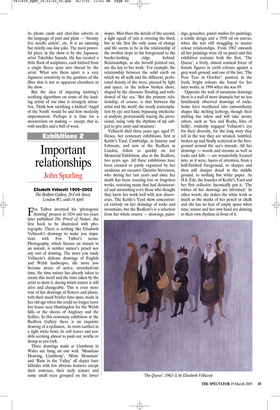Important relationships
John Spurling
Elisabeth Vellacott 1905–2002 The Redfern Gallery, 20 Cork Street, London W1, until 14 April Fox Talbot invented his ‘photogenic drawing’ process in 1834 and ten years later published The Pencil of Nature, the first book to be illustrated with photographs. There is nothing like Elisabeth Vellacott’s drawings to make you impatient with Fox Talbot’s terms. Photography, which freezes an instant in an instant, is neither nature’s pencil nor any sort of drawing. The more you study Vellacott’s delicate drawings of English and Welsh landscapes, the more you become aware of active, stretched-out time, the time nature has already taken to create this motif and the time taken by the artist to draw it, during which nature is still alive and changeable. This is even more true of her drawings of flowers and plants, with their much briefer time-span, made in her old age when she could no longer leave her house near Huntingdon for the Welsh hills or the shores of Anglesey and the Scillies. In this centenary exhibition at the Redfern Gallery there is an exquisite drawing of a cyclamen, its roots earthed in a tight white bowl, its soft leaves and tendrils seeming almost to push out, writhe or droop as you look.
Three drawings made at Llanthony in Wales are hung on one wall. ‘Mountain Drawing, Llanthony’, ‘Misty Mountain’ and ‘Rain in the Valley’ all depict bare hillsides with few obvious features except their contours, their turfy texture and some small trees grouped on the lower slopes. Mist blurs the details of the second, a light squall of rain is crossing the third, but in the first the only sense of change and life seems to be in the relationship of the swollen slope in the foreground to the harder-looking ridge behind. Relationships, as she herself pointed out, are the key to her work: ‘For example, the relationship between the solid earth on which we all walk and the different, perforated density of the trees, pierced by light and space; or the hollow broken shore, shaped by the alternate flooding and withdrawal of the sea.’ But the primary relationship, of course, is that between the artist and the motif, the steady contemplation by eye and hand, bypassing intellectual analysis, provisionally tracing the provisional, using ‘only the rhythms of my subject to give unity and structure’.
Vellacott died three years ago, aged 97. Hence, her centenary exhibitions, first at Kettle’s Yard, Cambridge, in January and February, and now at the Redfern in London, follow so quickly on her Memorial Exhibition, also at the Redfern, two years ago. All these exhibitions have been curated or partly organised by her assiduous art executor Quentin Stevenson, who during her last years and since her death has been rescuing lost or forgotten works, restoring many that had deteriorated and astonishing even those who thought they knew her work well with new discoveries. The Kettle’s Yard show concentrated entirely on her drawings of rocks and mountains, but the Redfern’s is a selection from her whole oeuvre — drawings, paint ings, gouaches, pastel studies for paintings, a textile design and a 1958 oil on canvas, when she was still struggling to master colour relationships. From 1962 onwards all her paintings were oil on panel and this exhibition contains both the first, ‘The Queue’, a lively, almost comical frieze of female figures in earth colours against a grey wash ground, and one of the last, ‘The Pear Tree in October’, painted, in the fresh, bright colours she found for her later works, in 1994 when she was 89.
Opposite the wall of mountain drawings there is a wall of more dramatic but no less fastidiously observed drawings of rocks. Some have weathered into extraordinary shapes like melting icebergs, though their melting has taken and will take aeons; others, such as ‘Sea and Rocks, Isles of Scilly’, evidently engaged Vellacott’s eye for their diversity, for the long story they tell in the way they are striated, tumbled, broken up and finally scattered in the foreground around the sea’s inroads. All her drawings — woods and streams as well as rocks and hills — are wonderfully focused into, as it were, layers of attention, from a half-finished foreground, to sharper and then still sharper detail in the middle ground, to nothing but white paper. As H.S. Ede, the founder of Kettle’s Yard and her first collector, laconically put it, ‘The whites of her drawings are informed.’ In other words, she makes the white work as much as the marks of her pencil or chalk and she has no fear of empty space when time, nature and her own hand are dancing to their own rhythms in front of it.
















































 Previous page
Previous page